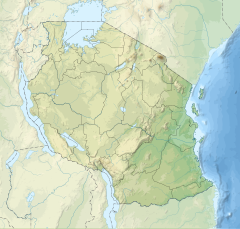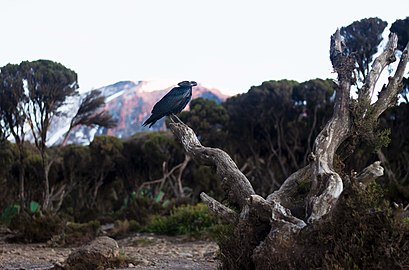Kilimanjaro National Park
| Kilimanjaro National Park | |
|---|---|
 The entrance to Kilimanjaro national park | |
| Location | Kilimanjaro Region, Tanzania |
| Nearest city | Moshi |
| Coordinates | 3°04′S 37°22′E / 3.067°S 37.367°E |
| Area | 1,688 km2 (652 sq mi) |
| Established | 1973[1] |
| Visitors | c. 52,000 per year[2] |
| Governing body | Tanzania National Parks Authority |
| Website | www |
| Type | Natural |
| Criteria | vii |
| Designated | 1987 (11th session) |
| Reference no. | 403 |
| Region | Africa |
Kilimanjaro National Park is a Tanzanian
The park generated US$51 million in revenue in 2013,[5]: 285 the second-most of any Tanzanian national park,[6]: 258 and was one of only two Tanzanian national parks to generate a surplus during the 2012–2013 budget year.[7] (The Ngorongoro Conservation Area, which includes the heavily visited Ngorongoro Crater, is not a national park.) TANAPA has reported that the park recorded 58,460 tourists during the 2012–2013 budget year, of whom 54,584 were foreigners.[7] Of the park's 57,456 tourists during the 2011–2012 budget year, 16,425 hiked the mountain, which was well below the capacity of 28,470 as specified in the park's General Management Plan.[8]
History
In the early twentieth century, Mount Kilimanjaro and the adjacent forests were declared a game reserve by the German colonial government.
Fauna
A variety of animals can be found in the park. Above the timberline, the Kilimanjaro
See also
Gallery
-
White-necked raven on Kilimanjaro
-
The Mount Kilimanjaro
-
Uhuru Peak - Mt.Kilimanjaro
References
- ^ a b c d e f "Kilimanjaro National Park World Heritage Site, Tanzania National Parks". Archived from the original on 30 September 2018. Retrieved 9 July 2013.
- ^ "Wings of Kili: Paragliding from Arica's highest peak". Daily News (Tanzania). Archived from the original on 29 January 2013. Retrieved 28 January 2013.
- ^ a b c d e f g h i j k Kilimanjaro National Park, World Heritage Center, United Nations Educational, Scientific and Cultural Organization
- ^ Mount Kilimanjaro National Park, Tanzania National Parks Authority Archived 2012-09-23 at the Wayback Machine
- ISBN 978-1-317-66874-9.
- ISBN 9781464801976.
- ^ a b Park arrivals highlights, Tourism Performance, Corporate Information, Tanzania National Parks, accessed 9 November 2015 Archived 20 December 2015 at the Wayback Machine
- ^ "PRESS STATEMENT: NUMBER OF MOUNT KILIMANJARO CLIMBERS NOT A THREAT", Tanzania National Parks, 5 March 2014, accessed 31 July 2015 Archived 24 September 2015 at the Wayback Machine





